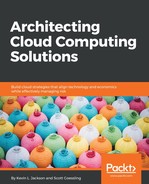While developing applications for the cloud is an essential area for the architect to understand, most large enterprises have some existing applications targeted for migration to the cloud environment. The cloud solution architect is intimately involved in these activities as well. Application migrations typically go through four distinct phases:
- Organizational assessment
- Solution definition and design
- Application migration
- Application operations
During the assessment phase, the migration team assesses the organization's infrastructure and targeted applications for readiness to transition to a cloud computing environment. Systems and applications owner interviews are core to this assessment. Application owners answer questions about their current application state as a prerequisite. Cloud adoption itself is an application portfolio activity. Interactions and dependencies between business applications may be more important than the data or application itself. Dependencies make the upfront screening, analysis, and hybrid infrastructure design crucial to the cloud readiness prescreening. This screening process captures as-is the application architecture and current sustainment costs. It also should provide the baseline data for migration option cost-benefit analysis to support the stakeholder's decision process. Migrating applications are typically targeted for one of four transition processes:
- Lift and shift: Required infrastructure is rebuilt using appropriate CSP services, and the application is transitioned as-is with no modifications.
- Refactor: Applications designed to operate on customized infrastructure are modified to leverage available cloud services before migrating.
- Rebuild: Applications that are still required by the organization but cannot be modified to use available cloud-based services. These applications are redesigned and rebuilt before transitioning the process to the cloud.
- Retire: Applications that are no longer operationally or economically viable to the organizations. Associated processes are either eliminated or replaced with available SaaS.
In the solution definition and design phase, organizational requirements and associated metrics are used to define, design, and compare candidate solutions. A multi-cloud analysis platform (MCAP) is typically used to support this stage. An MCAP enables enterprises, service providers, and systems integrators to model, design, benchmark, and optimizes information technology infrastructures. They are also used to design and model prospective system architecture alternatives. During this phase, to-be architecture options are reviewed to gain insight into mission suitability and an understanding of how migration impacts application performance, security, and scalability. This phase also encompasses finalizing all data security control requirements. Operational needs, laws, or industry regulatory dictates drive security requirements. Since security is a shared responsibility between the organization and selected cloud service providers, this activity identifies all required security controls and their application within the solution design.
In the application migration phase, applications first migrate into a sandboxed environment to complete functional and security testing. After verifying functional capabilities and security controls, they are promoted into the production environment.
In the application operations phase, the final operational entity starts managing the infrastructure and application. Users must continually monitor CSP adherence to service level agreements (SLA) throughout this phase. Continuous monitoring of all cloud-based resources is also necessary. The organization should continually recalibrate cost by comparing planned versus actual and should recommends policies to streamline cloud usage. As requirements and available market services improve, the transition to other service providers may be a more optimal choice.
